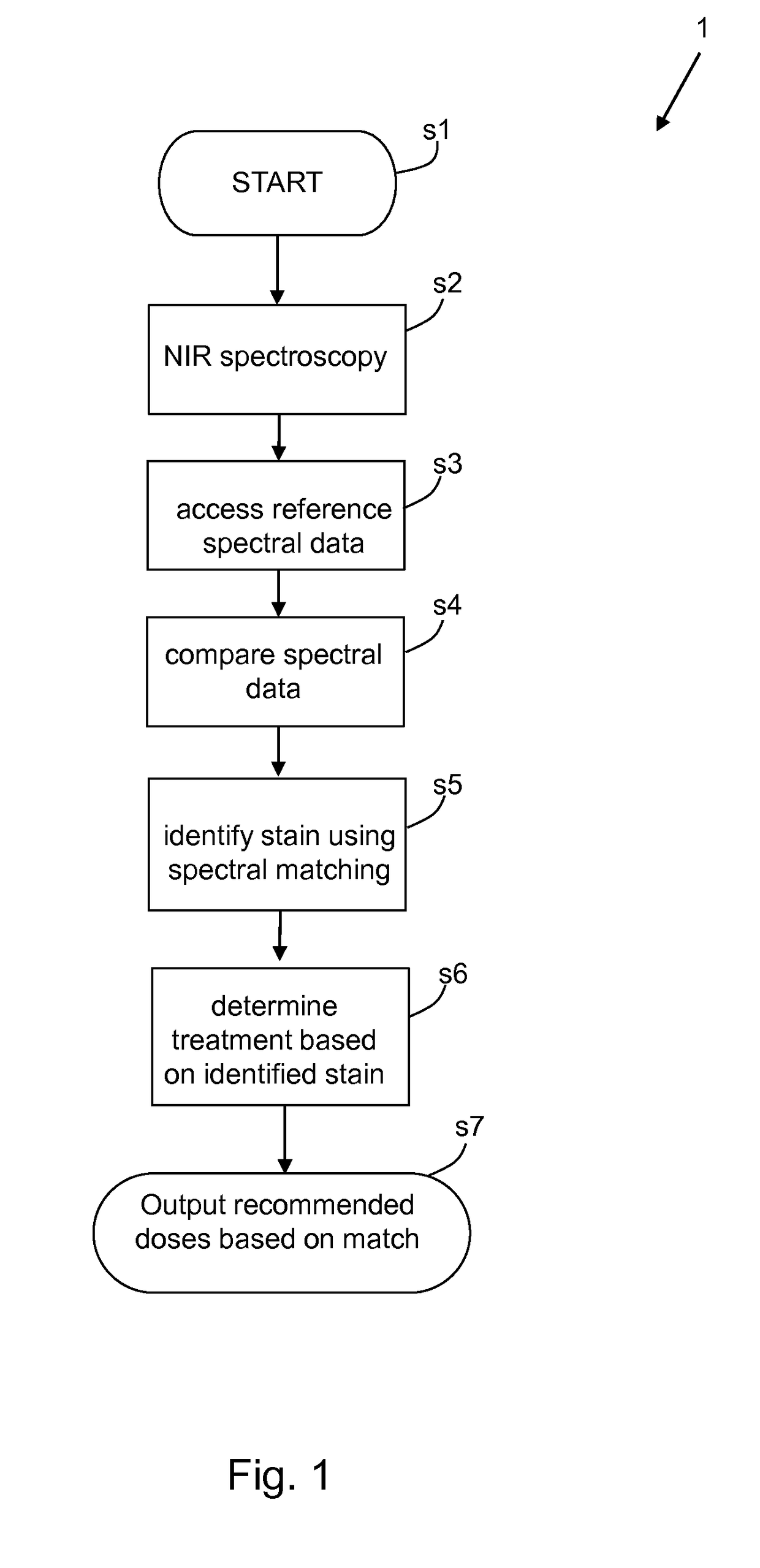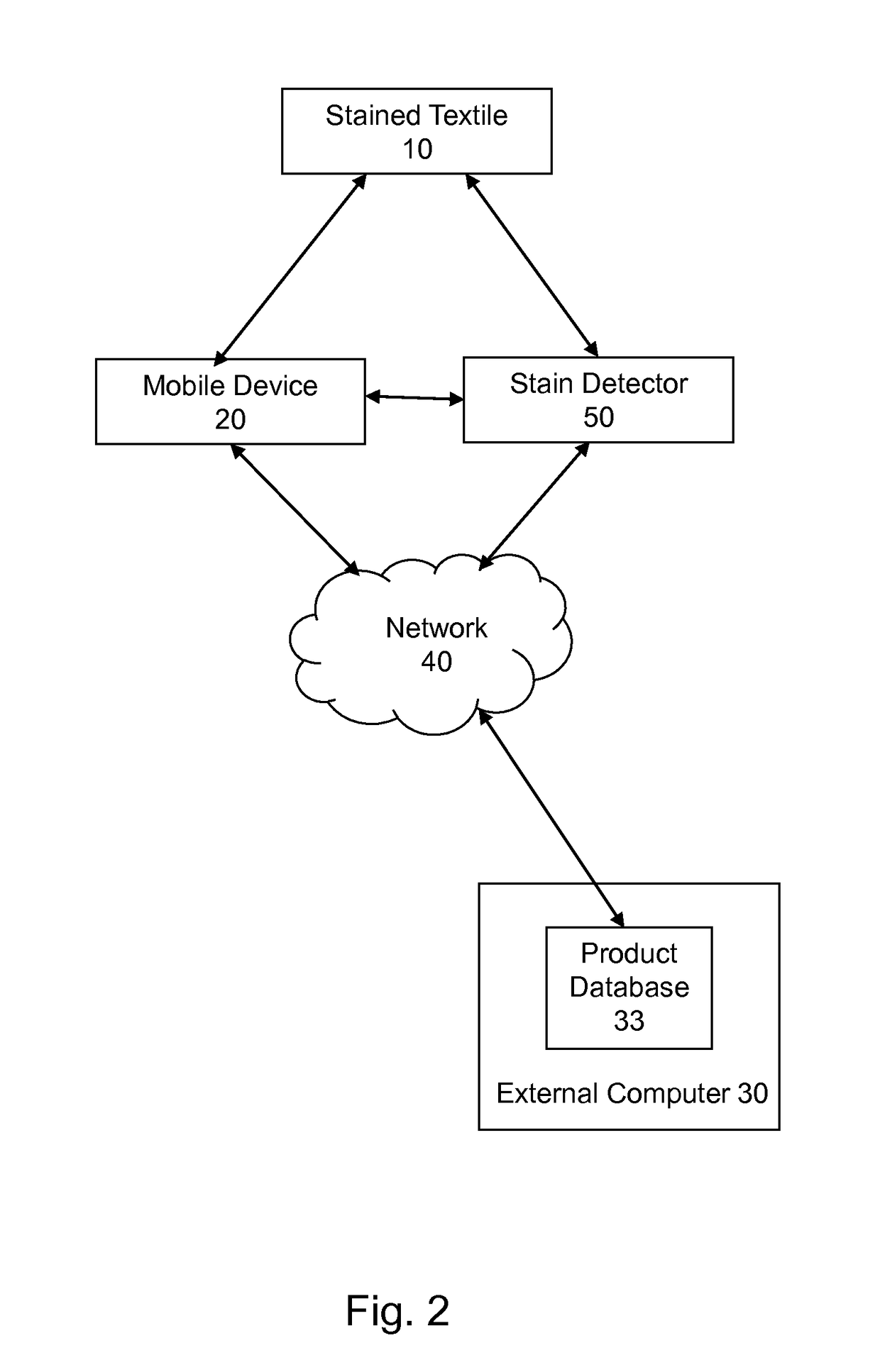Method and apparatus for stain treatment
a technology for stain treatment and textiles, applied in the field of methods and systems for identifying a stain on textiles, can solve the problems of undesired removal of colour from clothes, inability to achieve best cleaning results, and rarely targeted home laundry, etc., to achieve better defined bands, less penetration, and easy use
- Summary
- Abstract
- Description
- Claims
- Application Information
AI Technical Summary
Benefits of technology
Problems solved by technology
Method used
Image
Examples
example 1
ngth Stains
[0082]NIR spectral data were obtained for each of stains 1-24 applied to a cotton textile. The stains were given letter codes a-to-x respectively.
[0083]The NIR spectra were taken over a range of wavelengths ranging from a shortest wavelength of 1595 nm to a longest wavelength of 2397 nm.
TABLE 1results for full strength stainsStainStainno.Stain IDStain TypeBlood1aEnzymeTomatoSunflowerOil2bFattyLipstick3cFattyTangerine4dEnzymeBlank15etChocIceCreamPremium6fEnzymeBlackberryFruit7gBleachChocIceCreamEconomy8hEnzymeBlackShoePolish-CSS19iFattyGravy-Instant10jEnzymeGardenSoil(1:1water)11kParticulateRedSoil12lParticulateYellowPotteryClay13mParticulateChocPudding14nEnzymeYellowCurry15oFattyRedCurry16pFattyMakeUp117qFattyBlackCurrantJuice18rBleachBlackTea19sBleachRedWine20tBleachLardVioletDye21uFattyAnnattoOil22vFattyCookingOilVioletDye23wFattyMascara24xFatty
[0084]The resulting spectral data (i.e. the signatures acquired) were then compared with known values using the method describe...
example 2
ains
Washed Stains
[0093]This example concerned stains on a test textile of cotton (the same stains mentioned above in relation to Example 1). As described above in relation to Example 1, NIR measurements were taken of the stains, but this time, the test textile was washed first using a commercial liquid. This Example therefore attempted to identify washed stains using the model built for fresh stains.
[0094]Again, the method of the present invention was then carried out using the stain detection system 50 to identify the washed stains.
TABLE 3Results for washed stainsStainStainStainno.Stain IDAssignmentBlood1atTomato Sunflower Oil2btLipstick3cpTangerine4dtBlank15etChoc Ice Cream6ftPremiumBlackberry Fruit7gsChoc Ice Cream8htEconomyBlack Shoe Polish9iiGravy-Instant10jsGarden Soil(1:1 water)11keRed Soil12lsYellow Pottery Clay13mtChoc Pudding14ntYellow Curry15osRed Curry16ptMake Up117qtBlack Currant Juice18rtBlack Tea19stRed Wine20tsLard Violet Dye21upAnnatto Oil22vtCooking Oil Violet Dye2...
example 3
by Stain Type
[0099]In this example, the combined models (corresponding to both fresh stain and washed stain libraries) were combined and the application was then used on the instrument on textile samples.
[0100]As with Examples 1 and 2 above, NIR spectral data were obtained for each of stains 1-24 applied to a cotton textile. The stains were given letter codes a-to-x respectively.
[0101]The NIR spectra were taken over a range of wavelengths ranging from a shortest wavelength of 1595 nm to a longest wavelength of 2397 nm.
[0102]In the table below the results columns indicate the stain type by their initials:
[0103]Enzyme=E
[0104]Fatty=F
[0105]Particulate=P
[0106]Bleach=B
[0107]Note that there were two measurements taken (two separate stains of each stain type) so the table below includes two results for each sample.
TABLE 5comparison of results on concentrated and washed samplesResult onconcen-ResultStainStainStaintratedon washedStainno.IDTypesamplesampleBlood1aEnzymeEEPETomatoSunflowerOil2bF...
PUM
 Login to View More
Login to View More Abstract
Description
Claims
Application Information
 Login to View More
Login to View More - R&D
- Intellectual Property
- Life Sciences
- Materials
- Tech Scout
- Unparalleled Data Quality
- Higher Quality Content
- 60% Fewer Hallucinations
Browse by: Latest US Patents, China's latest patents, Technical Efficacy Thesaurus, Application Domain, Technology Topic, Popular Technical Reports.
© 2025 PatSnap. All rights reserved.Legal|Privacy policy|Modern Slavery Act Transparency Statement|Sitemap|About US| Contact US: help@patsnap.com



